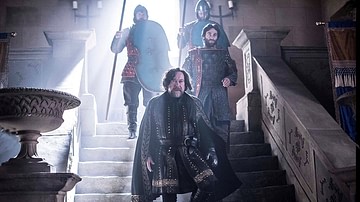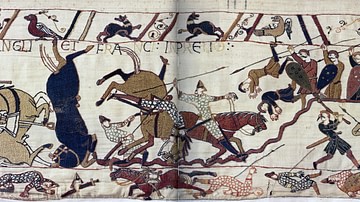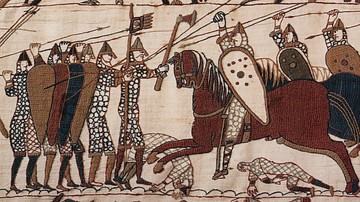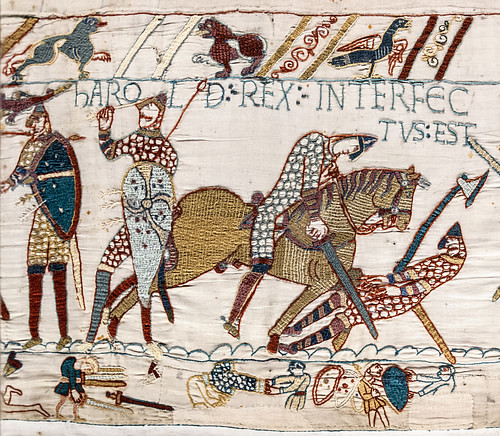
The Bayeux Tapestry shows in pictures the events leading up to the Norman conquest of England by William the Conqueror, Duke of Normandy, and his 1066 defeat of King Harold Godwinson at the Battle of Hastings. It was produced between 1067 and 1079, most likely by embroiderers working in Canterbury, England, and probably for Odo, the Bishop of Bayeux.
The tapestry is really an embroidery as the scenes are stitched not woven into the linen. It is the largest and best-preserved such work from the Middle Ages and is invaluable not only for its contribution to the story of the Norman invasion but also for its depiction of many aspects of medieval warfare and daily life. The tapestry is now on permanent public display in the William the Conqueror Centre of Bayeux in Normandy, France.
Material & Dimensions
The Bayeux Tapestry is an embroidered piece of multiple-banded linen fastened onto a backing cloth. It measures 68.38 metres (224 ft) in length and is 50 cm (20 inches) wide. The thread used to stitch the designs is mostly two-ply wool yarn with some use of linen thread. Using at least ten different colours, the threads were dyed using plant material. As the scenes on the cloth are stitched and not woven, the cloth is not technically a tapestry but the name has stuck from medieval times when such decorative hanging cloths or covers, however they were made, were known as a tapis or tapisserie.
The tapestry has 58 scenes of the Norman conquest of Anglo-Saxon England and the events which led up to it explaining (one might say justifying) William's claim to the throne of England. The scenes involve 626 characters as well as horses, dogs, ships, trees and buildings. They were probably stitched following an outline first drawn on the cloth by a single artist. The main scenes are bordered at the top and bottom by a strip showing fantastic animals like dragons and griffins, strange human figures, corpses and body parts. Some of these border scenes may represent fables or allude to certain moral behaviours and so offer a commentary on the main scene which appears directly above them. Stitched Latin words and phrases explain who or what is in the scene below. Very well-preserved and its colours still bright, only the last section of the tapestry is missing.
Historical Overview
The most likely place of the tapestry's production is Canterbury, England, but other possibilities include Normandy or the Loire Valley. The English connection is suggested by the style of the stitched scenes which resemble those seen in Anglo-Saxon manuscripts and by the fact that Canterbury did have a celebrated school of embroidery at the time. In addition, the Latin text often contains words spelt in the English manner. It was most likely made for Odo, the Earl of Kent (another Canterbury connection), Bishop of Bayeux and the half-brother of William the Conqueror. It is perhaps significant that Odo appears prominently in the tapestry itself. However, the tapestry was traditionally known as 'Queen Matilda's Tapestry' after William the Conqueror's wife, Matilda of Flanders, although there is no specific evidence of a connection.

Around 1077 the rebuilding of the cathedral of Bayeux was completed and consecrated by Bishop Odo. It is possible that the tapestry was then displayed to the public inside the cathedral, although the first reference to the tapestry in any text does not appear until 1476 when it is listed on the cathedral's inventory. Another possibility is that the tapestry was first hung in the great hall of Odo's private residence. For most of its existence, the tapestry was probably locked up in a chest, out of view in the cathedral's vaults. The French state took ownership of the tapestry following the French Revolution of 1792 and Napoleon Bonaparte briefly displayed it in Paris as a timely anti-British propaganda tool. In 1842 the public of Bayeux could once again see their tapestry when it was put on display in the town's public library. Kept safe in Sourches and then the Louvre in Paris during the Second World War, the tapestry was returned to Bayeux after the war. There have been several minor repairs to the tapestry over the years and, since 1983, a dedicated space has been given to the tapestry in Bayeux's William the Conqueror Centre (Centre Guillaume le Conquérant).
The Story of the Norman Conquest
The majority of the scenes which together tell the story of the Norman Conquest match in many instances with medieval written accounts even if there are, as one might expect with a purely visual narrative, some omissions such as the Anglo-Saxons' battle with Norway's Harald Hardrada at Stamford Bridge three weeks prior to Hastings. Again because it is a visual account, with only a few Latin words as pointers, many scenes are open to several interpretations. The tapestry starts with a scene set in 1064 where the English king Edward the Confessor (r. 1042-1066) says farewell to Harold Godwinson, his brother-in-law and the Earl of Wessex, who is to travel to Normandy on an unknown mission. Norman writers would record the mission's purpose as a pledge of Saxon loyalty to William, Duke of Normandy, while an English chronicle suggests it was merely a visit to secure the release of Saxon prisoners.

Next, Harold's ship is blown off course and on reaching landfall he is captured by Count Guy of Ponthieu. William orders Harold's release and enrolls him in a battle with Duke Conan of Brittany. Harold fights well and is depicted favourably as a brave warrior who even manages to save two of the enemy from quicksand. Afterwards, Harold is knighted by William, although the fact he holds a banner and the Latin rubric mentions 'arms' may show that Harold has been given back his banners and is now a vassal of the Norman duke. Harold swears an unknown oath to William with his hands on holy relics, and then returns to England. Some commentators have suggested that because William has a sword in his hand in this scene, the oath was taken under duress and, therefore, whatever the oath actually was could later be honourably broken by Harold.
On his death bed, King Edward (his beard a little longer since we last saw him), who was without an heir, nominates Harold as his successor (January 1066). We have the funeral of King Edward at Saint Peter's in Westminster and then the coronation of Harold. The new king is given his crown by the Archbishop of Canterbury, Archbishop Stigand who had been excommunicated by the Pope. Again, some commentators suggest this scene indicates the illegitimacy of Harold's claim and support of William's to the English throne, especially considering other sources do not have Stigand perform that role. It is interesting to note the ghostly uncoloured ships in the lower border of this scene – a hint at the invasion to come perhaps?
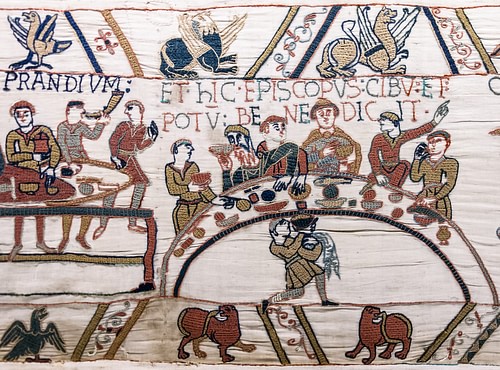
The next scenes (now taking place in September) show the Normans preparing to invade Britain by building ships and gathering horses, men and supplies, including one huge wine keg important enough to get its own caption. On landing in southern England, William has his men build fortifications and they are shown looting the countryside and burning homes. Normans are seen cooking meat and Bishop Odo sits at a table which is remarkably like an illustration from a Canterbury manuscript of Christ's Last Supper.
The major subject of the tapestry is now dealt with: the Battle of Hastings in October 1066 which covers one-third of the tapestry. The Norman cavalry, wearing chain mail or padded armour and armed with spears, lances and long swords, takes centre stage. The Anglo-Saxons, many only wearing ordinary tunics, carry spears, axes and single-edged swords. Only Harold amongst the Saxons is shown riding a horse. The Saxon strategy is to create close formations of foot soldiers protecting each other with their shields while the Normans favour cavalry. There are violent details, arrows and spears fly over the battle scenes, and there are the dramatic deaths of Harold and his two brothers Gurth and Leofwine. Victorious, the Norman cavalry chase the remaining Saxons from the battlefield.

A Window into Medieval History
The tapestry reveals many details, even if they may contain artistic license, of life in the Middle Ages. There are motte and bailey castles, great halls, churches, houses, ships, medieval banquets, hunts with falcons and hounds, a coronation, all manner of clothing, armour and weapons galore, and even an appearance by Halley's Comet. Medieval warfare is one obvious subject which is illuminated by the tapestry. For example, the shields depicted in the tapestry indicate that coats of arms or individualised devices were not yet commonly used, although both William and Harold may have had them. The tapestry shows two types of Norman archers distinguishable by one group wearing armour and the other seemingly in rags which would suggest both professional and conscripted archers were used.
Aspects of daily life depicted include the common wardrobe of tunics and hose for men of all status, with long dresses for the few women depicted. National fashions are shown such as the Normans' preference for very short hair with high-shaved necks and the Saxons' for long hair and moustaches. Agricultural scenes show ploughing, the sowing of seeds and scaring off of birds. There is even one of the earliest depictions of a working horse with a collar-harness and plough.
Despite all these fascinating images, there are some details and omissions which may be inaccurate such as archers with spurs (leading some commentators, without any corroborative evidence, to suggest the Normans used mounted archers). There are no depictions of crossbowmen in the tapestry despite the fact they are known to have been employed in France at the time – perhaps the artists simply did not know how to represent them. There are oddities too, such as Edward the Confessor's funeral being shown before the king's death, as if a mistake has been made in the sequencing between outlining and stitching. One major point of discussion is Harold's death. The king is shown with an arrow in his head or eye but there is evidence this was put in the scene during the 19th century restorations. On the other hand, small holes in the linen suggest there was something there in the original – perhaps a lance. Then, of course, even if there was an arrow there originally, we still cannot be sure that was what actually happened. Is it a case of the tapestry recording history or recording the later legends which had grown around the history?
Finally, there are several scenes which have defied centuries of interpretation and remain a mystery such as a tonsured priest seemingly caressing a woman called Aelfgva, a bearded dwarf figure possibly named Turold, or the small naked human figures in a portion of the border, one of whom wields an axe. The biggest mystery is, of course, what the final missing scene was. Theories include a possible coronation scene of William, made King of England in Westminster Abbey on Christmas Day 1066, which would nicely balance the depiction of King Edward on his throne at the beginning and Harold seated on his throne in the centre of the tapestry.

